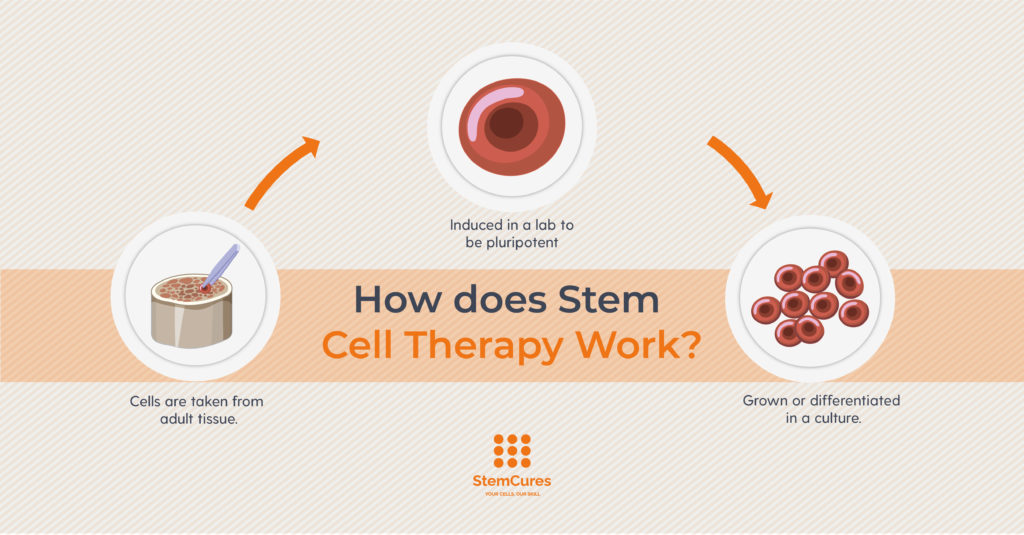What Can Stem Cell Therapy Help Treat?
Stem cell therapy is a promising medical treatment that has the potential to treat a wide range of health conditions.
It involves the use of stem cells, which are immature cells that have the ability to develop into many different types of cells in the body. These cells are transplanted into a patient to help repair damaged tissue, replace lost or damaged cells, or to stimulate the body’s natural healing processes.
With its regenerative capabilities, stem cell therapy has shown promising results in treating conditions with chronic pain conditions such as osteoarthritis, spinal stenosis, and multiple sclerosis. Muscle and spine injuries including muscle, ligament, and tissue repair, cartilage repair, and repairing degenerative discs. As well as effectiveness in curing diseases such as Parkinson’s disease, and other conditions that affect the organs, tissues, and bones.
What are stem cells and what do they do?
You may have heard conversations surrounding stem cells, but it’s important to have an accurate understanding of what they are and what they do.

Stem cells are fundamentally the building blocks of the human body, and they are often referred to as “master cells” because of their unique ability to develop into all different cell forms. Master cells produce “daughter cells” which go on to become organ cells, blood cells, bone cells, and muscle cells, all of which work to repair damaged tissue. Another aspect of stem cells that makes them special is their ability to self-renew, which means that they can also become brand new stem cells.
The 4 Different Types of Stem Cells
There are four different categories of stem cells, some of which are more versatile than others. These types include:
- embryonic
- adult
- induced pluripotent
- perinatal stem cells
Each type has its own uses, but adult stem cells are the ones used in stem cell therapy. This is an important distinction to make, as other types have been far more controversial for being taken from patients without proper consent.
Adult stem cells, on the other hand, are drawn from the patient’s own body through fat or bone marrow, and they have shown tremendous results. Furthermore, bone marrow stem cells are the most FDA-compliant out of the various types that are used to treat pain.
Stem cells are the only cells in the human body that have the ability to create new cell types. Therefore, the purpose of stem cell therapy is to harness the one-of-a-kind power of stem cells and turn it into treatments that can help treat various medical conditions and diseases.
What are some of the medical conditions that can be treated with stem cell therapy?
The most common condition that can be treated with stem cell therapy is chronic pain, specifically back pain, and joint pain.
People who suffer from arthritis or are recovering from injuries or surgery are also likely to reap the rewards of stem cell therapy. These types of pain affect millions of Americans, and in many cases, surgery, medication, and physical therapy cannot provide adequate relief or create more problems than they solve. Patients who have participated in stem cell treatments in clinical trials have had high success rates, with 70 to 80% of patients reporting marked improvement.
What are some of the diseases that can be treated with stem cell therapy?
There is evidence that shows that people who suffer from type 1 diabetes, Parkinson’s disease, Alzheimer’s disease, heart disease, stroke, cancer, and osteoarthritis may benefit from stem cell treatments that utilize adult stem cells. Scientists have made strides in testing the use of adult stem cells in treating other illnesses and degenerative diseases, like heart failure. At present, there is only one use of stem cell therapy that is approved by the FDA, and that is for the treatment of certain types of blood cancers, such as leukemia, lymphoma, neuroblastoma, and multiple myeloma.
How is stem cell therapy performed?
Consultation
During your consultation, you’ll be informed as to which type of injection is best suited to your own needs and what you should expect on the day of your procedure. One of the many reasons that stem cell therapy is appealing to patients is because it is performed in a minimally invasive, non-surgical procedure, typically in an office or clinical setting. More often than not, stem cell treatments take no longer than 90 minutes to administer, and when compared to surgical alternatives, they are relatively painless.
Extraction
The first step in stem cell therapy involves doctors aspirating stem cells from the patient’s bone marrow or fat. This process is not painful, as local anesthetics and sedation are used, as well as small needs that help perform extractions painlessly. Next, those samples are processed in a centrifuge machine, resulting in the valuable parts of those cells being extracted to maximize potency.
Injection
Those stem cells are then administered to the patient by way of injection into the specific part of the patient’s body that is causing pain or inflammation. There are four types of injection that may be used, depending on the type and location of pain or inflammation. Stem cells can be administered via intravenous injections, intra-articular, intramuscular, or through an intrathecal procedure, which many people know as a lumbar puncture.
What are the risks and benefits of stem cell therapy?
Benefits
There are many benefits to receiving stem cell therapy, the most significant of which for most patients is pain reduction.
The pain relief resulting from stem cell treatment has the potential to be long lasting, which is a sharp contrast to taking pain medication, which wears off in just a few hours and can also be addictive. Where medication only masks pain, stem cell therapy is regenerative, helping to treat pain at the source. Additionally, stem cell therapy can potentially speed up recovery times for patients who are recovering from surgery or an injury. Receiving stem cell therapy often helps patients experience better quality of life and improved mobility.
Another key benefit of stem cell therapy when compared to other treatments is that it is non-invasive and does not require general anesthesia. Where surgical procedures pose several potential risks and possible complications, the risks and complications associated with stem cell therapy are far fewer and there is no risk of nerve damage. Because stem cells used in stem cell therapy are taken from the patient’s own body, there are no risks of patients catching diseases or infections.
Considerations
However, as is true of any medical procedure, there are some risks associated with stem cell therapy.
Some patients experience minor side effects like fatigue, nausea, and headaches, and, less commonly, fever and chills, though these usually clear up in a few hours. People who have active cancers or blood disorders may not have a good reaction to stem cell therapy, and should speak with their primary care physicians before moving with stem cell treatments. Other uncommon, but possible risks include bleeding or bruising, allergic reaction to anesthetics, or infection. Having stem cell treatments performed at a reputable clinic helps reduce the likelihood of any potential risks.
How much does stem cell therapy cost?
It’s important to seek out a legitimate and reputable clinic in order to ensure the best possible results from stem cell therapy.
You will want to be sure that the procedure is being performed by a qualified physician who is injecting cells from your own bone marrow into the precise location for targeting pain. Furthermore, the process of aspirating an adequate number of stem cells from bone marrow is time-consuming, and the procedure itself can take anywhere from ninety minutes to two hours to perform. Ultimately, your results will typically be a reflection of the doctor who administers the treatment, therefore the procedure can be costly. While the price will vary from case to case and patient to patient, reputable clinics will often charge between $4,000 and $8,000 for stem cell therapy.













